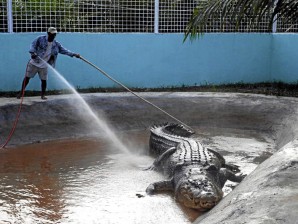‘Buwaya’ in the limelight
 Crocodiles or buwaya are once more in the news, but this time in their original incarnations and not their human versions. We’ll get to those in time.
Crocodiles or buwaya are once more in the news, but this time in their original incarnations and not their human versions. We’ll get to those in time.
Crocodiles are back in the limelight after the capture of a 6.4-meter-long brackish water crocodile dubbed “Lolong” by the media and the local folk. Lolong, who it is hoped will make an appearance in the Guinness Book of World Records as the world’s largest crocodile, was captured in Agusan Marsh, a big part of which is located in the province of Agusan del Sur.
“Lolong’s” capture has also focused national and international attention on the Marsh itself which in 1994 was placed under the National Integrated Protected Area System (Nipas), effectively putting a stop to crocodile hunting in the locality. Dr. Jurgenne Honculada-Primavera, an internationally recognized biologist and “scientist emerita” with the SEAFDEC Aquaculture Department, writes that the ban on hunting “removed humans as top predator from the food chain, leaving the crocodiles to grow in numbers as well as body size.”
Lolong, and an even bigger nine-meter Crocodylus porosus, believed to be the so-called “monster” croc that “killed and decapitated a young girl on her way home from school in March 2009,” have been used to open discussions on the need to “control” the size of the crocodile population in the Agusan Marsh.
“Guesstimates are made of some 5,000 crocodiles in the marsh, and options to build a bigger facility versus enclosing a portion of the natural habitat for Lolong are debated,” writes Primavera. “Sadly lacking in all these is science—without accurate information, possible human-crocodile encounters will continue. All it takes is one, just one, attack on a tourist, and Agusan del Sur can forget its dreams of ecotourism.”
* * *
Instead of mass hysteria and sensationalism, Primavera suggests the proper response should be to convene a “workshop of a dozen or so crocodile experts with knowledge of wild populations (e.g., scientists of the Mabuwaya Foundation, Agusan del Sur DENR-PAWCZMS staff, and veteran crocodile hunters in the marsh) or breeding animals (the Crocodile Farm Institute in Palawan ).”
The workshop could “assess what is known of brackish water crocodiles both in the marsh and elsewhere, point out information gaps, and prioritize research topics. What is the niche of C. porosus in the vast marsh ecosystem? How many of these reptiles are in the swamps and rivers, in what sex ratios and sizes? What is the carrying capacity of the marsh for crocodiles? For humans? For humans and crocodiles? Do crocodiles mate for life? What is their breeding, parental and other behavior? Where exactly along the Agusan River, or in the marsh (other than Lake Mihaba) do they rest, feed, nest and undertake the daily activities of crocodile life? Such knowledge will provide the basis for a regulatory framework to include the culling (controlled harvest) of wild crocodiles to stabilize their population numbers, and the zoning of the marsh into residential, fisheries, navigational, tourism and other zones. (Growing up in flood-prone Butuan City, I would listen to tales of crocodiles leaving their river haunts to take a swim in inundated city streets during the rainy season.)”
* * *
Primavera calls on the DENR-PAWB, DOST and other national agencies to organize the workshop, with local government officials providing the logistics and “for all to fund the research needed to estimate harvest quotas for culling, to delineate safe navigational routes, and to delimit settlements out of harm’s way for Manobos and other marsh residents. It is important to preserve and protect the environment of the marsh, Primavera adds, for it “acts like a sponge to absorb the waters from the Upper Basin and regulate their downstream flow, saving Agusan del Norte, Butuan City and the rest of the Lower Basin from catastrophic floods.” She adds: “Agusanons and Mindanaoans should have the opportunity to visit the Agusan Marsh at least once in their lifetime, as much for its ecological importance as its magical beauty.”
* * *
It so happened that I was in Butuan City last week, taking part in a Program Consultation on a three-year “Regional Program to Promote Gender Equality in Political Participation” in Bangladesh, Cambodia, East Timor, Vietnam and the Philippines.
The program, supported by the Spanish development agency Paz y Desarrollo (Peace and Development), in the Philippines is concentrated in Butuan and Agusan del Norte and in Lanao del Sur and Marawi City. Program partners locally are the Women and Gender Institute of Miriam College, the Philippine Council on Women, and Pilipina.
The consultation gathered local government officials and citizens, especially indigenous peoples, youth and women, to share views on issues of governance and development, and project directions to improve their lives.
Pilipina, in particular, will be working on capability-building for duty bearers (appointed and elected officials and their staff in the LGUs), while campaigning for active citizenship through responsible voting, in Lanao del Sur and Marawi City. This is particularly important in light of the elections for the ARMM, given the reform agenda being pursued by the Aquino administration, and the pursuit of peace not just with the MILF, but among all the warring groups in Mindanao.
At no time in the course of the consultation were the crocodiles of the Agusan Marsh mentioned, but both in the formal plenaries and workshops, the “buwaya” of the human kind, particularly those in suits and barong of officialdom, were often mentioned. Which brings up the question of which kind of crocodile should be protected and which should be marked for extinction.















